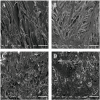Biodegradability and biocompatibility study of poly(chitosan-g-lactic acid) scaffolds
- PMID: 22418927
- PMCID: PMC6268052
- DOI: 10.3390/molecules17033243
Biodegradability and biocompatibility study of poly(chitosan-g-lactic acid) scaffolds
Abstract
A biodegradable, biocompatible poly(chitosan-g-lactic acid) (PCLA) scaffold was prepared and evaluated in vitro and in vivo. The PCLA scaffold was obtained by grafting lactic acid (LA) onto the amino groups on chitosan (CS) without a catalyst. The PCLA scaffolds were characterized by Fourier Transform infrared spectroscopy (FT-IR) and scanning electron microscopy (SEM). The biodegradabilty was determined by mass loss in vitro, and degradation in vivo as a function of feed ratio of LA/CS. Bone marrow mesenchymal stem cell (BMSC) culture experiments and histological examination were performed to evaluate the PCLA scaffolds' biocompatibility. The results indicated that PCLA was promising for tissue engineering application.
Figures









References
-
- Bi L., Cao Z., Hu Y.Y., Song Y., Yu L., Yang B., Mu J.H., Huang Z.S., Han Y.S. Effects of different cross-linking conditions on the properties of genipin-cross-linked chitosan/collagen scaffolds for cartilage tissue engineering. J. Mater. Sci. Mater. Med. 2011;22:51–62. doi: 10.1007/s10856-010-4177-3. - DOI - PubMed
Publication types
MeSH terms
Substances
LinkOut - more resources
Full Text Sources
Miscellaneous

